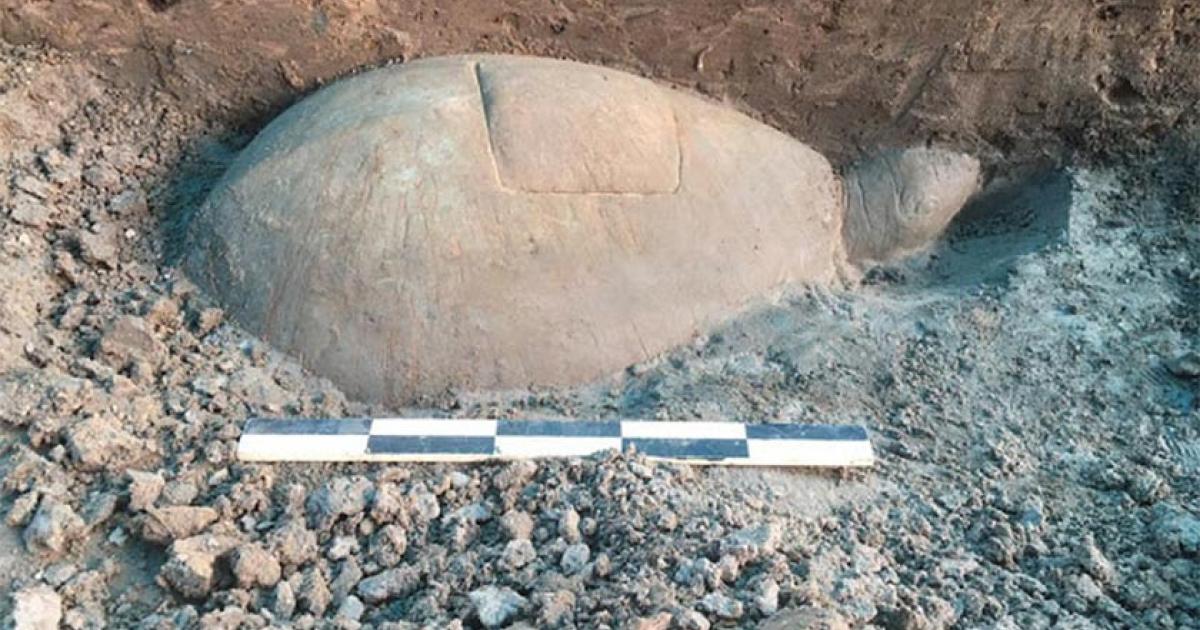
Rare Turtle Statue Found Submerged in Angkor Reservoir
Archaeologists have made a historic discovery in the middle of an Angkor reservoir. A rare turtle statue was recovered near one of the most famous temples in Cambodia and could provide experts with a new perspective on the development of Angkor Wat, which is one of the most renowned archaeological sites in Asia, if not the world.
The amazing find was made by a team from the Apsara Authority, who were working at the Kandal Srah Srang temple in Angkor Archaeological Park, which is in the Siem Reap province of Cambodia. This temple is mostly sunk beneath the waters of a man-made reservoir. Archaeologists have made a number of important discoveries at the Angkor reservoir, including a stone dragon head and two tridents.

The Srah Srang reservoir site at sunset, Angkor Archaeological Park, Cambodia. (steph photographies /Adobe Stock)
A Big Turtle Statue Stays in Place
While working near the temple site, they also unearthed a large turtle statue, that measures 23 by 37 inches (58 by 93 cm). It was found beneath the water and workers had to drain the area so archaeologists could excavate the stone figure.
- Lost City of Khmer Empire Finally Found in Cambodia!
- Exquisite 12th Century Lion Sculpture Dragged From Reservoir in Cambodia
- Ten Amazing Cities from the Ancient World

The turtle sculpture found in the Angkor reservoir is believed to have been placed as an offering in the temple’s foundation. (Apsara Authority)
The Khmer Times quotes Chea Socheat, who led the team of archaeologists, and said “the turtle sculpture bore no distinct patterns, except for a square impressed on its shell.” Long Kosal, a spokesperson from the Apsara National Authority, told Xinhua “The large tortoise statue was made of sandstone.” The turtle statue has only been partially exposed and has not been removed.
The Daily Sabah reports that ‘The bottom half of the turtle remained buried Thursday while preparations were being made to lift it out while ensuring it remained intact.’ Great care is needed so that the sculpture is not damaged. Long Kosal is quoted by Cambodia Daily as saying that “it is unclear yet how big or heavy the tortoise is.”
The Glories of a Temple Submerged in the Angkor Reservoir
According to The Star, ‘the remnants of the temple can be seen peaking over the waterline in the dry season’. Srah Srang is completely submerged during Cambodia’s wet season. It appears that at some date the artificial island upon which the structure was built sank into the sediment of the Angkor reservoir or baray.
This temple is believed to date to the 9th or 10th century AD and was rebuilt by King Jayavarman VII. It was built in the Khmer style of architecture that was influenced by South Indian buildings. Some of the original landing points that were built to allow people to access the temple can still be seen. Archaeologists have unearthed a burial site with the cremated remains of many individuals near the sunken temple.
The Kandal Srah Srang temple was once one of the many wonders of Angkor Wat. Angkor Wat was the capital of the Khmer Empire, which was the dominant power in South East Asia for much of the Medieval era. It was an Indianized kingdom and was heavily influenced by Buddhism and Hinduism. This Empire collapsed in the 15th century because of environmental factors and foreign invasions.
- Back to Angkor: Researchers Unlock Why Khmer Kings Left Koh Ker
- New research unravels rise and fall of ancient Cambodian city Mahendraparvata
- Mosquito Hordes: How a Pesky Insect Destroyed the ‘Almost’ Invincible Mongol Empire
A Glimpse into Khmer Rituals and Ceremonies
The Hindu-Buddhist culture of the Khmer Empire is crucial in helping experts to understand the turtle statue. Similar objects have been found at Khmer temples such as Lor Ley, but the one found at Sran Srang is much larger.
Chea Socheat told The Khmer Times that “The turtle is known as one of the avatars of the Hindu god, Vishnu.” Depictions of turtles were often ritual offerings and they were placed in the center or foundations of temples. However, experts cannot definitively state if this was the case for this particular statue, though they believe the sculpture may have been used as part of some religious ritual or celebration.
The Khmer Times quotes Chea Socheat as saying that “Our recent discovery can help explain the history of the temple, including the religious ceremonies that were once performed here.” There have been many archaeological studies of the site but there have been no systematic investigations based on the objects unearthed.

Trident found at Kandal Srah Srang Temple in Siem Reap province. (Apsara Authority)
Thus, this rare find in the Angkor reservoir could help experts to better understand the culture and religion of the Khmer Empire.
Top image: The rare turtle statue was found in the middle of an Angkor reservoir in Cambodia. Source: Apsara Authority
By Ed Whelan















